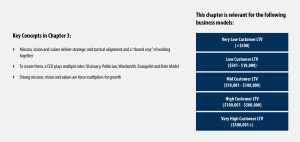
Mission mobilizes. Vision visualizes. Values vitalize.
Mission, vision, and values are the big three. They inform your market focus — the customers you seek, and those you don’t. They paint a picture of the world you hope to create. They stipulate the agreed upon norms.
If these bold proclamations are to be respected, every person in your company will hold every leader in your company accountable. Yes, your top team’s actions and decisions must be in full alignment with the proclamations you have made. So too with your brand identity. Mission, vision and values state who you are and who you aspire to become. For your external facing brand to be an authentic representation of your company, it also must be fully aligned.
A great mission statement clarifies:
- What you do
- For whom
- Why
A great vision statement:
- Clarifies what “mission accomplished” looks like: how the world has changed. It defines your future history.
Great values express the core truth of your aspirational culture. They act as a rallying cry, said with few words, to:
- Clarify
- Direct
- Expect
- Inspire
What’s the yield from a focus on mission, vision, and values? Each member of your team possesses a large reservoir of potential. When the mission is clear, you get strategic and tactical alignment. When the vision is clear, you get commitment, perseverance, and even joy in the opportunity to co-create a better future. And when values are clear, you get enthusiastic buy-in to a “shared way” of working together towards common goals. Via this path, passion is unlocked — and with passion, potential. People will stretch further, work harder, give more and care more. As they experience personal growth, they unleash company growth.
Together, mission, vision, and values comprise your north star. Through the storms of your startup voyage, whenever you lose your way, hold your sextant up to them: the direction forward will become clear again.
Early in my career, I was privileged to witness the power of mission, vision, and values statements to transform a company. It was at the Minneapolis Star Tribune.
The internet had just begun to explode, and multiple threats were on the horizon. I was fortunate to be on the team charged with reinventing the Star Tribune’s future. After six months of intensive work, the result was not just a transformational strategy, but a new statement of mission, vision, and values that awakened an incredible period of innovation and growth.
The new mission statement seemed innocent enough: “To enhance the shared life of the community by being the area’s leading provider of information and communications that people value.” Take note: it did not mention newspapers, or even news. The key phrase was “information and communications.”
From this mission spawned an intense period of Web 1.0 innovation. For example, we created an online jobs site based on a resume database for professionals. This was an early incarnation of the model eventually adopted by Monster and perfected by LinkedIn. We created a real estate website with searchable listings and photos, one of the many early experiments that eventually yielded Zillow. And startribune.com became regarded in journalistic circles as a top tier online news site on the leading edge of innovation.
We didn’t understand at the time that online innovation focused on just one market was unsustainable. It took us a few years to work out that the online sites for jobs, cars, real estate and so forth worked best as multi-market platforms. But at the time, that early online innovation elevated our brand and spurred overall growth (the Star Tribune’s annual recruitment ad revenues alone hit $90M in the late nineties, and overall revenue grew strongly, approaching $400M).
Similarly, there were new company values: customer focus, employee involvement, continuous improvement, and diversity. These values were taken seriously and spawned a whole new management paradigm at the company: a culture that was innovative, respectful, data driven, and employee involved. We became highly focused on improving customer satisfaction. Sure enough, Gallup researched customer satisfaction before and after these changes, and reported unprecedented improvements.
Mission, vision, and values should be enduring. There are just three times in the scaling of a company where it makes sense to visit them:
- At company inception
- When you have reached proof of product / market fit — usually around $3M in revenue.
- At a major pivot point — where a change in the core assumptions of your business is required (such as with the Star Tribune)
My focus is on the latter two. In the first, you don’t know enough. In the other two, you do. Hard-won experience (such as feedback from your prospects, customers, board, exec team, and employees) yields the data necessary to inform mission, vision, and values.
So how do you do it?
In the drama to create a powerful mission, vision, and set of company values, you as CEO are a five-part actor: Visionary, Politician, Wordsmith, Evangelist and Role Model. Your goal isn’t just to come up with the right words — though that’s important. It’s also to engage your team so deeply that the words are true, are believed, and come to life — visible both inside and outside of your company.
Visionary
What market do you serve? What problem do you solve now, and how will that change over time? How will your market evolve? How will you drive that evolution?
These questions are informed by:
- A thorough understanding of your market, your customers, and the pain points you seek to address
- Your conviction as to the trends and the disruptions that will mark the evolution of your chosen market
- The role you see your company playing in those trends and disruptions
Politician
In the development of the mission, vision, and values, it’s not enough to find the right words. For the words to come to life, you must ignite belief and shared ownership in the hearts of your employees. Here’s how:
- Have a retreat with your exec team
- Hold town halls
- Pull together small-group sessions in each functional area of your company
- Walk around and talk with everyone
- Discuss
- Debate
The mission, vision, values creation phase is an excellent moment of opportunity to build belief through active participation. Like a politician, you can test your ideas with employees — discovering what resonates, then iterating and optimizing — until you’ve landed on words that are true to what you believe, but also incorporate perspectives gleaned from team members at all levels. This bi-directional creation process simultaneously yields the right words and the team’s belief thus making a powerful impact, that is efficiently instantiated.
Wordsmith
- Words matter
- Minimize the number of words per value (1–3)
- Minimize the number of values (3–5)
- Maximize the impact of each
Evangelist
Evangelism starts once the mission, vision, and values have been committed to words. The evangelist role is best described by example. Victor Ho is CEO of FiveStars, a company that offers customer loyalty programs for small businesses. Victor and his team have thought deeply about the mission, vision, and values. And they have worked very hard to actuate the words in the daily life of the company.
FiveStars Mission:
- “We help businesses and communities thrive by turning every transaction into a relationship.”
FiveStars Values:
- Shared Humility
- Authentic Relationships
- Warrior Spirit
- Joy Every Day
In developing the list of values that would define the FiveStars culture, the team started from the premise that employees are the most sustainable source of competitive advantage, and the culture you create is your most sustainable product. Victor and his team determined they would build a set of values that were not behavioral, such as “the customer comes first” or “always pursue excellence.” Rather, the established values would be attitudinal. As such, Victor’s team ascertained that the right behaviors would naturally flow from the right core attitudes.
For instance, the value “Shared Humility” results in the behavior of reliance on each other, and a desire to attack problems, not each other. The value “Authentic Relationships” results in direct and honest engagement, being clear about issues while acknowledging each person’s struggles and challenges. The value “Joy Every Day” doesn’t mean you’re always happy — it means that the team exhibits an abiding sense of optimism and stability that helps weather the storms of startup life.
Victor is an evangelist. Here’s how:
- Until recently (FiveStars is now over 400 employees), he met directly with every new employee, giving a presentation on the company’s mission, vision, and values
- The values are front and center at every town hall meeting
- The values hang on a big banner at corporate headquarters
- Monthly awards are given to employees who uniquely exhibit the values
- Performance reviews now assess an employee’s alignment with the company values
- Everyone is expected to be able to quote the mission and values of the company at any time, and they can, and they do
( Listen to Victor discuss mission and values at FiveStars and his role in making them real.)
Role Model
As CEO, it’s on you to live the words you’ve created. Your team will learn more from what you do than what you say.
Mission, vision, and values comprise the granite foundation for the castle that is your company. Upon this foundation rests culture, market focus, product vision, brand identity, and more. Designed well, your foundation will soundly bear the load as the castle above it rises and rises relentlessly towards the stars.
Rock on!

